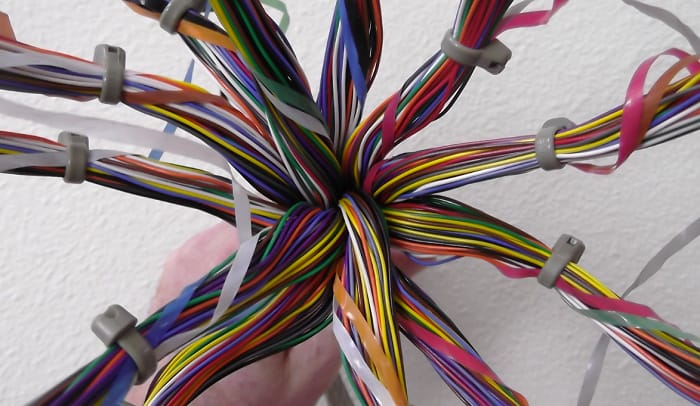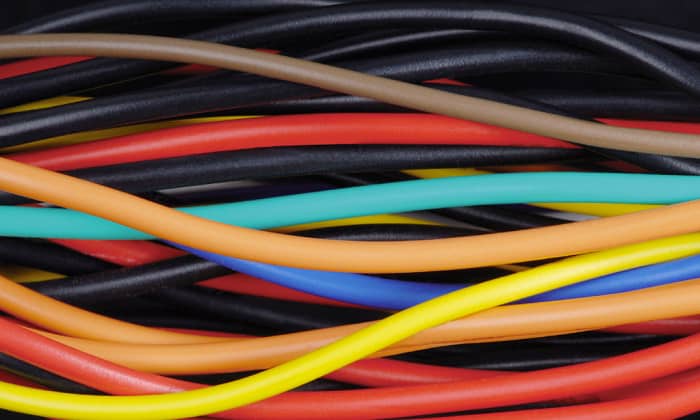If you’re getting conflicting answers to “What size wire for 200 amp service?” and want to double-check, this post will provide the best, safest wire recommendation and explain how we arrived at it.
Based on Table 310.12 of the NEC, you can use a 2/0 copper wire or a 4/0 aluminum wire size – with voltage drops relative to the distance not factored in.
Underground services may use either schedule 40 or 80 PVC conduits sized between 1.5 inches to 2.5 inches to accommodate all essential wiring.
Table of Contents
The Most Recommended Wire Size(S) for 200a Services
The 200A service recommendations of 2/0 copper and 4/0 aluminum wires were made with the 83% standard in mind.
Summed up, it means that your 200 amp service wire size’s ampacity should not be less than 83% of the main service’s rating. Take note: this rule only applies to services rated between 100 amps to 400 amps.
Also, the sizing above only applies to single-phase dwelling services, assuming your property falls into that category. If you compare the inputs from Table 310.16 standard wire size chart with the ones in Table 310.12, you’ll end up with different figures.
Still, the two tables are tied together. We’re just considering the 83% standard, as proven by the following calculation:
200A x 83% = 166A
Now, go check out the inputs in Table 310.16, and you’ll see that the figures and recommendations make sense.
2/0 copper is rated for 175A (based on the 75° C column), which is perfect, since it still leaves a nice buffer. The same can be said for the 4/0 aluminum wire, which works for 180A.
So, yes, you can consider either gauge as the most suitable 200 amp residential service wire size and entrance cable size. This also applies to the neutral wire size, since it should be the same size as the line conductor.
Without a doubt, home wiring is what most people who have this query are concerned with, so I went ahead and focused on that. What’s important is that you don’t end up with an undersized wire as that leads to a fire threat and may damage the wire’s insulation.
Related: Ideal Wire Size for a 50 Amp Sub Panel
Different Types of Wire
Why do the tables in the NEC only consider copper and aluminum? Simply put, they conduct electricity very well and are readily available. Here’s how one differs from the other:
1. Copper
Copper is the better conductor. The downside is that it’s not cheap. Supply chain disruptions caused by the pandemic only add more wood to the fire.
Demand for copper won’t dwindle anytime soon, though. Most can’t get enough of its standout perks, such as better elasticity, notable durability and strength, and ease of pulling despite their heavier weight.
Heftier weights don’t necessarily mean you get the shortest end of the stick, though. After all, thieves won’t be all too willing to dig up or snatch your wires if they weigh a ton.
2. Aluminum
Aluminum wires gained a reputation as a cheaper alternative to their copper counterparts. They’re lighter in addition to being less conductive and ductile.
However, aluminum wires have better electrical resistivity and tend to be quicker to install because they’re highly bendable and lighter.
Even though many homeowners can save plenty of dough when opting for aluminum, they still tend to prefer copper wires because they last longer. Other downsides of aluminum include proneness to corrosion and overall flimsiness.
One other head’s up: 2/0 or 3/0 copper and 4/0 aluminum are not the same as 2 AWG, 3 AWG, and 4 AWG wires, respectively. The former wires are bigger and thicker.
2/0 copper wires will work better with a 200 amp breaker, as said above and proven in the tables, while 2 AWG copper wires are better paired with a 100 amp breaker. One is almost or exactly twice the other’s capacity, in short.
Other Important Factors to Consider
1. Voltage Drop
Besides 2/0 copper or 4/0 aluminum, feel free to upsize, especially if you’re dealing with longer distances that worsen voltage drops. The NEC makes it clear that any setup over 5% voltage drop should upgrade wire size.
Let’s say you’re installing a 200 amp sub panel or a new panel that you’re going to assign as the main panel.
Lengths over 100 feet should involve wire upsizing, as most engineers’ and electricians’ notes would say. In this case, a 3/0 copper wire may be ideal. It’s way better to put up with the minor downsides of upsizing than the more serious risks posed by undersized wires.
How am I making these recommendations? By adding 20% more amps for every 100 feet. This is another common practice by electricians to avoid using excessively small wires.
- For 200 amp panel that’s 300 ft from the main service, you’ll need to adjust the wire size for 266 amps (with the 83% standard considered).
We got it with the following equation:
200 x 160% = 320A
320A x 83% = 266A
Checking Table 310.16 again, that means you need at least to use 300 MCM copper or 400 MCM aluminum.
- At 400 feet, the gauge wire for 200 amp service should either be 350 MCM copper or 500 MCM aluminum.
- If you’re working with distances spanning 1000 feet, it may be time to call a professiona Such distances will require you to use larger, more expensive wires to keep voltage drop down and will also need you to calculate the exact voltage drops you’re dealing with.
A licensed electrician should be able to suggest better solutions for you.
2. Conduit
Above-ground installations typically need flexible and rigid conduits. Underground applications have no other option but to use solid PVC options.
Depending on your chosen type of conduit, length of run, and wiring layout, you may need bends, elbows, couplings, fasteners (to prevent conduit contraction), straps and clips, etc.
Consult with an inspector and electrician to get the sizes right and confirm the permits you need, especially if you need to break anything to make room for wires or even do some trenching.
3. Cost
Rising copper prices makes installing wires expensive. Shortages and disruptions obviously don’t help to bring them down. Add to that the (often) pricey labor fees, and it’s no wonder homeowners prefer to take wiring projects into their own hands.
Always weigh the pros and cons of copper and aluminum wires when considering this factor.
FAQs
How much does it cost to install 200 amp electrical service?
On average, you should expect the price to be a little over or under $1,500. Underground wiring systems may cost as much as well, but don’t be taken aback if your electrician hands you a quote charging for twice that amount.
Can I run a 200 amp subpanel off 200 amp main?
This is entirely possible and allowed. You will have 200 amps in total to work with since that’s the main’s total capacity.
This is actually a great match, especially if you already have wires in place for the 200 amp main. You won’t even need a dedicated breaker for it because the service’s 200 amp main breaker will provide the protection.
You can attach the subpanel’s wires directly to subfeed lug kits. Here’s a video of how these kits work if you aren’t familiar with them:
NQ Sub-feed Lug Kits (1 of 2): 100/225A
Conclusion
To summarize my answer to “What size wire for 200 amp service?”, it should at least be 2/0 copper or 4/0 aluminum. Feel free to bump the size up to accommodate the total length of the cable’s run and keep the voltage drop within safe levels.
Don’t overlook conduit sizes and any deviations from your budget you may encounter. As always, it’s best to plan the wiring before you install it.

I am Edwin Jones, in charge of designing content for Galvinpower. I aspire to use my experiences in marketing to create reliable and necessary information to help our readers. It has been fun to work with Andrew and apply his incredible knowledge to our content.



